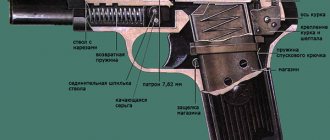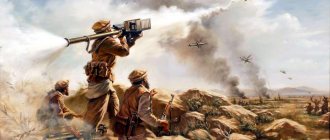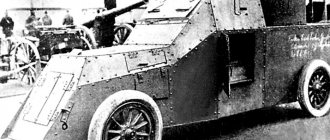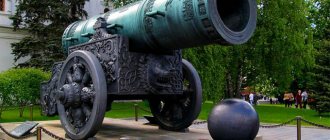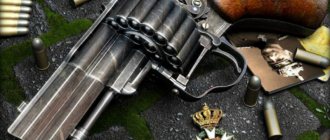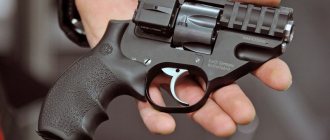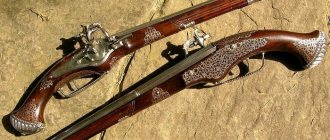History of creation
The Makarov pistol was adopted for service in 1951. It was used by personnel of the USSR security forces. The production of weapons was carried out at a plant in Izhevsk. In the 90s, the number of orders for PM from the country's security forces decreased sharply, due to the establishment of arms trade with the CIS countries. As an alternative, Izhevsk engineers created a sports training version of the Makarov pistol called “Baikal-442”.
When developing weapons, Russian engineers focused on the domestic and American markets. Large deliveries of the new model to the USA were planned, but due to the politically unstable situation, trade was never established.
Model features
The Baikal-442 pistol is similar in design to the famous PM. It has a mechanism for automatically reloading cartridges, powered by the recoil energy of the bolt. Firing mode - single, with manual or automatic cocking of the hammer after each shot.
The Baikal-442 model differs from the Makarov pistol by the presence of an adjustable sight located on the bolt. The weapon has a permanent front sight, and the sight can be moved in vertical or horizontal directions. There are modifications with a permanently fixed aiming mechanism. The pistol can be additionally equipped with a laser sight, which simplifies the process of aimed shooting at targets. The laser target designator is located in front of the trigger guard.
Advantages:
- Convenient design;
- Reliability of mechanisms;
- Light weight.
Modern Application
The purpose of the Baikal-442 pistol is training shooting. The model is made of durable steel, guaranteeing a long service life. The automatic system has a simple device, a free shutter. There are several options for the external finishing of the model: blued, nickel-plated metal.
The Baikal-442 pistol uses 9x18 mm caliber cartridges. There are 3 types of magazines of different capacities. For the model, reinforced Parabellum cartridges measuring 9x19 mm are produced in magazines of 8 pieces. Early models were produced with a rounded trigger guard, similar to the Makarov pistol. Subsequently, the shape of the bracket changed and received a small protrusion for ease of shooting with two hands.
Baikal-442
Category:
Pistols
Country of origin: Russia
Baikal-442 is officially classified as a sports training pistol; however, it differs from the Makarov PM combat pistol only in the presence of adjustable sights instead of standard non-adjustable ones. Thus, Baikal-442 can also be considered as an improved combat pistol. It is supplied to the European arms markets and is in good demand due to the optimal price-quality ratio.
Design features Baikal-442 has the same automatic mechanisms as the PM, which operate on the basis of the recoil of a free shutter, made in the form of a movable barrel casing. The bolt return spring fits directly onto the barrel. The hammer-type impact mechanism has an open hammer and a two-pronged mainspring located in the handle behind the magazine. The trigger mechanism allows only single fire. The presence of self-cocking allows, if there is a cartridge in the chamber, to fire the first shot without first cocking the hammer. This increases the weapon's combat readiness without compromising safety. Initially, all pistols were produced with the same trigger guard as the PM, however, in the latest release pistols, the shape of the trigger guard has been changed - there is a protrusion in the front part of it, which increases the convenience of shooting with two hands. To protect against corrosion, the metal parts of the gun are blued. The handle pads are made of impact-resistant plastic.
Safety mechanism Protection against accidental shots is provided by a safety lever located in the rear part of the bolt. It locks the trigger and the bolt with the frame at the same time. The safety can be turned off with the thumb of the hand holding the weapon, i.e. the gun can be controlled with one hand.
Ammunition 9 x 18 mm PM cartridges are used as ammunition for pistols of variants 442-101, 442-102 and 442-103. These options are equipped with box-shaped steel magazines with a capacity of 8, 10 and 12 rounds, respectively. The 442-104 variant is designed to fire 9 x 19 mm Parabellum cartridges, widely used in the West, and its magazine holds 8 rounds. After the cartridges are used up, the bolt, with the help of the magazine feeder and the bolt stop, stops in the rearmost position.
Sights Sights include a permanent front sight and a sight that is adjustable vertically and horizontally. It is possible to install a laser target designator.
GSh-18
Category:
Pistols
Country of origin: Russia
The pistol was developed at KBP by academicians V.P. Gryazev and A.G. Shilunov, taking into account the requirements of the GRAU (Main Rocket and Artillery Directorate) of the Russian Army for modern army pistols. Work on its creation was completed in the late 1990s. It received the designation GSh-18 after the initials of the authors and the magazine capacity (18 rounds). On March 21, 2003, by decree of the Government of the Russian Federation 166, the pistol was adopted for service (along with the PYa pistols designed by Yarygin and SPS designed by Serdyukov). The GSh-18 has been in mass production since 2001. It is used to equip officers and sergeants of army units (including special forces), as well as special forces soldiers of the Ministry of Internal Affairs.
Design Features Although the GSh-18 belongs to a new generation of weapons, its automation mechanisms operate according to a long-established and well-developed scheme based on the use of recoil energy from the barrel during its short stroke. The barrel bore is locked by rotating the barrel by analogy with the Steyr pistol of the 1912 model. But if the Austro-Hungarian prototype had a barrel rotated by 42°, then the GSh-18 rotated only by 18°. This locking system not only provides more reliable operation in difficult conditions; but it also helps to reduce perceived recoil, since turning the barrel after a short stroke redirects part of the recoil energy to rotation of the barrel. The pistol has a double-action trigger mechanism with preliminary partial cocking when the bolt moves and additional cocking when the trigger is pressed. When firing a shot, the finger first presses the protrusion of the automatic safety into the trigger, and with further pressure on the trigger, a shot occurs. The firing pin of the pistol in the cocked position protrudes slightly from the bolt, which allows you to determine whether the pistol is ready to fire visually or by touch. The trigger stroke is approximately 5 mm, the trigger force does not exceed 2 kg. The shutter-casing consists of two parts - the casing and the shutter itself. The casing is stamp-welded; its blank is rolled up from a 3-mm steel sheet, welded at the joint and finished by milling. The barrel of the pistol is made by cold forging, and some parts are produced using precision investment casting technology, which ensures high precision manufacturing. The frame is made of high-strength thermoplastic "Armamid PASV30-30MTU", the physical properties of which combine optimal elasticity and rigidity.
Ammunition The pistol is designed to fire 7N21i cartridges. The bullet of this cartridge penetrates a steel sheet 8 mm thick at a distance of 23 meters, which is much greater than the penetration of bullets of many pistol cartridges. The cartridges are fed from a double-row box magazine with a capacity of 18 rounds. The magazine release is located on the left side of the handle. After the last cartridge from the magazine is used up, the bolt-casing is held by the bolt stop in the rearmost position.
Sights Sights are non-adjustable. They include a non-replaceable rear sight and a replaceable front sight. A replaceable front sight can be equipped with luminous tritium inserts, making it easier to aim the weapon at dusk. The possibility of attaching a laser target designator is provided.
Modifications A pistol version chambered for the 9 x 19 mm Parabellum cartridge has been developed. This pistol is intended for supply to European arms markets.
IZH-71
Category:
Pistols
Country of origin: Russia
The IZH-71 pistol belongs to a new class of weapons for Russia, called “service.” According to the Russian law “On Weapons”, this is a portable melee defensive weapon, inferior in all indicators of effectiveness to service (combat) weapons of the army and police, and which cannot be converted into a similar combat weapon without changing the set of main parts. The pistol is mass-produced and supplied to private security services and various formations.
Design Features The IZH-71 was created by converting a PM combat pistol to chamber a relatively low-power 9 x 17 mm Browning Kurz or 380 Auto cartridge. However, the design of the base pistol has undergone only minimal changes. They affected mainly the barrel with the chamber and the magazine. Like the base pistol, the automatic mechanisms of the IZH-71 operate using the recoil energy of a free (non-engaged) bolt with a stationary barrel. The trigger mechanism ensures firing by self-cocking or with pre-cocking of the hammer. Safety mechanism The pistol has a non-automatic safety, the flag of which is located in the rear part5 of the bolt. In the “on” position, it locks the bolt with the frame and the trigger.
Ammunition The pistol is chambered for 9 x 17 mm Browning cartridge. Magazine capacity - 8 or 10 rounds.
Sights Sights are non-adjustable. They include a front and rear sight. A laser target designator can be attached to the frame in front of the trigger guard, which is turned on by pressing the trigger in the free-wheeling area. By special order, the pistol can be equipped with a sight that can be adjusted vertically and horizontally.
Modifications In addition to the main variants IZH-71 / 071-101 with a magazine capacity of 8 rounds and IZH-71 / 071-102 with a magazine capacity of 10 rounds, the IZH-71 N / 071-103 variant with a magazine capacity of 12 rounds is also produced.
Margot
Category:
Pistols
Country of origin: Russia
The compact pistol "Margot" is produced by the Izhevsk Mechanical Plant as a training pistol! At the same time, the relatively low cost, good accuracy and fairly high stopping effect of a shellless bullet of a 5.6 mm target cartridge make the pistol very convenient for use as a self-defense weapon. Moreover, due to the low penetrating power of the bullet, the pistol is an ideal weapon when carrying out sting operations in aircraft flying at high altitudes - damage to the fuselage skin from such a bullet is minimal, and there is practically no possibility of ricochet.
Design Features When developing “Margo,” specialists from the Izhevsk Mechanical Plant used the excellent sports pistol M.V. as a base. Margolin chambered for the 5.6 mm MTs-1 cartridge, produced with a non-self-cocking firing mechanism with an open hammer. The trigger mechanism includes a comfortable trigger, pull rod and hammer sear. The protrusion of the rod serves to separate it from the sear by the moving shutter-casing. The return spring is placed under the barrel, its rod is fixed with a pin. To make the pistol more compact, the barrel length was reduced to 98 mm; however, the considerable length of the pistol and the large width of the handle make it difficult to carry concealedly. All metal parts are made of high quality weapon steel. Protection of parts from corrosion is ensured by their blued finish. At the customer's request, the gun can be supplied in a “white” version. In this case, the parts are subjected to chemical nickel plating.
Safety mechanism The pistol is protected from accidental shots due to the presence of a safety cocking mechanism. A version of the pistol has also been developed with a special safety lock, which blocks the firing pin in the on position.
Ammunition The ammunition used is a 5.6 mm “long target” cartridge (.22 LR). The cartridges are fed from a box magazine with a capacity of 7 cartridges inserted into the handle.
Sights The pistol has non-adjustable sights, including a front sight and rear sight. At the request of the customer, a sight can be installed on it, adjustable in the vertical and horizontal planes.
Modifications For use by law enforcement operatives, the “Margot” modification is produced for a more powerful 5.45 x 18 mm MPTs cartridge. This pistol is given the name "Drill". Unlike the Margot, it has a magazine with a capacity of 10 rounds.
MP-435
Category:
Pistols
Country of origin: Russia
The elegant compact pistol MP-435 is produced by the Izhevsk Mechanical Plant on special orders. It is intended to be used for self-defense and to defeat the enemy at short distances. Thanks to its small size and the absence of protruding parts, it fits comfortably in a jacket pocket, handbag or small holster. Can be used by law enforcement officers, and also by special forces (as a backup weapon).
Design Features MP-435 has minimal dimensions and weight. The weight reduction is ensured due to the fact that the frame and bolt-casing are made of aluminum alloy, and the use of a single-row magazine contributed to maintaining the dimensions to a large extent, due to which the thickness of the handle was reduced to 25 mm. The length of the handle was also shortened, but to securely hold the pistol during shooting, a stop for the ring finger of the shooting hand was attached to the bottom of the magazine. Pistol automatic mechanisms operate on the principle of blowback. The trigger mechanism is striker-type; the pistol can only be fired by self-cocking. Metal parts are made of high-quality weapons-grade steel using high-precision technological equipment. A new durable coating was used to finish the pistol.
Safety mechanism The pistol has a non-automatic safety. The fuse box is located in the rear part of the bolt casing.
Ammunition The .22LR cartridge is ideal for this pistol as it has enough power without causing too much recoil. The cartridges are fed from a box-shaped single-row magazine with a capacity of 5 rounds.
Sights The pistol is equipped with non-adjustable sights - front sight and rear sight.
MP-443 (6P35) "Rook"
Category:
Pistols
Country of origin: Russia
The design of the pistol was started by specialists from the Izhevsk Mechanical Plant under the leadership of V.A. Yarygin in 1993 and was carried out according to the tactical and technical assignment adjusted in the same year for the competitive theme “Rook” of the USSR Ministry of Defense, which provided for the creation of a new army pistol to replace the PM. At the development stage, the pistol was designated “PYA” (Yarygin pistol). The pistol was also given the factory designation MP-443 “Rook”, and the sample submitted for field testing was also given the designation. (An army pistol developed at TsNIITOCHMASH is also being tested under the same designation). In 2000, it was announced that the PYa pistol won the competition for a new army pistol, but by Decree of the Government of the Russian Federation No. 166 of March 21, 2003, it was accepted into service along with two other participants in the competition - GSh-18 and SPS.
Design Features The MP-443 has recoil-type automatic mechanisms with a short barrel stroke and rigid locking of the barrel bore by skewing its vertical plane, one combat protrusion in the breech behind the window for extracting cartridges in the bolt (modeled on the Browning High Power pistol). The breech of the barrel is lowered to disengage from the bolt using a shaped cutout in the boss under the barrel, interacting with the bolt stop axis. The pistol is equipped with a double-action trigger mechanism. The trigger is covered on both sides by protrusions of the bolt-casing, which prevents it from getting caught on clothing or ammunition. At the same time, it is possible to fire by self-cocking or with manual cocking. The pistol has a comfortable grip. On the front surface of the trigger guard there is a protrusion that has already become traditional, which increases the reliability of holding in the hand when shooting with two hands. The pistol barrel is made of stainless steel. The remaining metal parts are made of high-quality weapon steel. To protect against corrosion, metal parts are chemically oxidized.
Safety mechanism The pistol is equipped with a non-automatic safety with a double-sided control lever. When turned on, the safety locks the sear, trigger and bolt. The trigger can be locked both in the cocked and deflated state. A double-sided safety and a magazine latch that can be reinstalled on both sides allow you to shoot with the right or left hand. The function of indicating the presence of a cartridge in the chamber is performed by the ejector.
Ammunition The pistol uses the Russian 9 x 19 7N21 cartridge as ammunition. This cartridge has an armor-piercing bullet with a heat-strengthened steel core, weighing 5.4 grams, developing a muzzle velocity of up to 450 m/s (muzzle energy - about 550 J). In terms of the maximum pressure developed in the barrel, the 7N21 cartridge is significantly superior to commercial 9x19 mm Parabellum ammunition, and therefore can only be used in weapons specially designed for it. At the same time, weapons chambered for the 7N21 cartridge, including PYa, can be used without problems with most commercial 9x19 mm cartridges, as well as with the 9 x 19 mm NATO cartridge. The cartridges are fed from a 17-round steel box magazine with a staggered arrangement of cartridges and a double-row exit to the loading line.
Sights The pistol has non-adjustable sights, including a front sight and rear sight.
Modifications Further development of the MP-443 became pistols MP-444, MP-445, MP-446
MP-444 "Bagheera"
Category:
Pistols
Country of origin: Russia
The Izhevsk Machine-Building Plant is implementing a large-scale project that will significantly expand the plant’s export capabilities. We are talking about creating two basic models of pistols, conventionally called “light” and “heavy”. Both models are created on a single design basis, and the developed modifications of these pistols “cover” the entire range of currently produced 9-mm pistol cartridges. The MP-444 "Bagheera" is a "light" basic model chambered for relatively low power cartridges.
Design Features The pistol has a modern external design, new materials are used in its designs, and production is carried out on high-precision technological equipment. The pistol frame is made of high-quality injection molded thermoplastic and has stamped steel guides - front and rear. The front guide is fixed by the shutter stop axis, the rear by a screw. When unlocking and locking, the barrel moves along the guides due to the interaction of the bevel on the lower protrusion of the barrel with the bevel on the base of the return-buffer mechanism. Thanks to the return-buffer mechanism, shock absorption of the barrel and bolt in the rearmost position is ensured. All metal parts of the pistol are made of high-quality weapon steel and equipped with an anti-corrosion coating. The automatic mechanisms used in the pistol work by using the recoil energy of the barrel during its short stroke. The barrel bore is locked by entering the barrel protrusion, located above the chamber, into the extraction window of the bolt-casing. The pistol has a striker-type impact mechanism, which is equipped with a special cocker that looks like a trigger. This device allows the shooter to cock the firing pin manually and fire both self-cocking and with pre-cocking of the firing pin.
Safety mechanism When developing the pistol, special attention was paid to protection against accidental shots. The pistol is equipped with automatic and non-automatic safety locks. Non-automatic fuse - flag. When its flag is in the Upper position, the trigger mechanism is blocked without resetting the firing pin. This allows you to carry the weapon in a cocked position and quickly open fire with a low trigger pull. When the safety flag is moved beyond the fixed position, the firing mechanism is removed from the firing mechanism without firing a shot. An automatic safety device is located on the bolt and blocks the firing pin until the trigger is fully pulled.
Ammunition Based on the MP-444, a family of pistols is being developed for 9 x 18 mm PM and PBM, 9 x 17 mm Browning and 9 x 19 mm Parabellum cartridges. They are equipped with a steel double-row magazine for 15 rounds. Sights The pistol has non-adjustable sights - front sight and rear sight, located on the bolt-casing. To facilitate aiming in the twilight, the front sight is equipped with one contrast mark, and two more such marks are on the rear sight.
Modifications This pistol's magazine holds 10 rounds. There are no other differences from the base model MP-444.
CP-1 “Gyurza”/”Vector”
Category:
Pistols
Country of origin: Russia
The SR-1 pistol was developed by specialists from the TsNIITOCHMASH enterprise in accordance with the tactical and technical requirements of the competition theme “Rook”. It underwent field testing in 1992. After the Ministry of Defense temporarily stopped funding work on the Rook theme, the pistol was modified to meet the requirements of the Russian intelligence services, in particular the FSB (Federal Security Service) and the FSO (Federal Security Service). At the same time, a pistol complex was created, which in 1996. adopted by special forces of the law enforcement agencies of the Russian Federation under the designation SR-1. The complex is designed to defeat living targets wearing body armor of 1, 2 and 3 protection classes (type Zh-81, Zh-86-2), which meet foreign standards NILECJ-STD-0101.01 and MILC-44050, as well as various technical means (vehicles, cabins and antennas of radar systems, missile bodies, etc.) at ranges up to 100 m.
Design features The SR-1 pistol complex includes the following components: a) 9-mm RG055 pistol; b) a cartridge with an armor-piercing bullet RG052 (later the cartridge received the designation .9 x 21 mm SP-10); c) accessories (holster, spare magazine, cleaning rod, cord). RG055 has an elegant modern design; it is designed with automatic mechanisms that operate by using recoil energy during a short barrel stroke with its rigid locking by a cylinder swinging in a vertical plane located under the barrel. The return spring is located around the movable barrel. The pistol is equipped with a double-action trigger mechanism with an open hammer. The peculiarity of this mechanism is that the self-cocking mode is possible only when the trigger is placed on the intermediate “safety” cocking. The pistol frame has a mixed design. Its upper part is made of steel, and the handle with the trigger guard is made of high-strength injection molded thermoplastic. Metal parts Made of high-quality weapon steel, their outer surfaces are coated with anti-corrosion coating.
Safety Mechanism The pistol is equipped with two automatic safeties - on the trigger and on the back of the handle.
Ammunition The 9 x 21 mm SP-10 high-efficiency cartridge is a completely new development of TsNIITOCHMASH (author A. Yuryev) and meets modern requirements for penetration of various obstacles. The high penetration ability of the cartridge used is achieved due to the original design of the bullet and the choice of the optimal ballistic solution. The cartridge provides penetration of body armor containing one or two titanium plates 1.4 mm thick and 30 layers of Kevlar at ranges up to 50 m or a steel sheet 4 mm thick at ranges up to 50 m. It is superior to pistol cartridges of domestic and foreign production for similar purposes. lethal effect by 1.3 and 1.4 times. After the CP-1 pistol complex was adopted for service, a number of more cartridges were included in its composition, including cartridges with an expansive and low-ricochet bullet. The cartridges are fed from box magazines with a capacity of 18 rounds. The magazine release button is located behind the trigger on the handle.
Sights Sights are non-adjustable. They include a front and rear sight.
